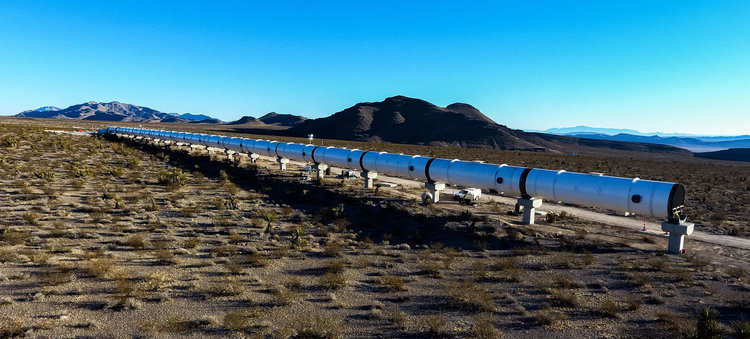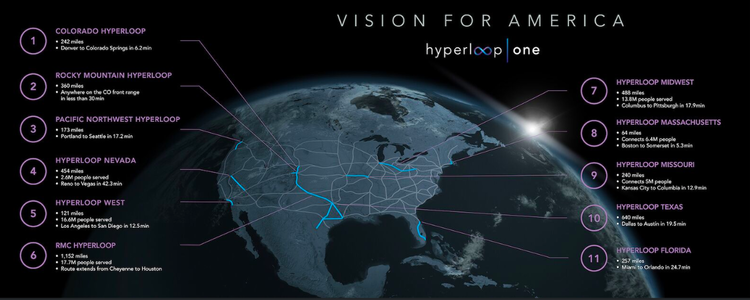Building momentum: This video on the Hyperloop One partners was only released three weeks ago.
If critical mass has not yet been achieved for the ultra-ambitious Hyperloop, it sure seems near.
Propelled by disruptive innovators like Elon Musk and Peter Diamandis, and now backed by AEC giants like AECOM, ARUP, and BIG, the once-fanciful, science-fictional dream of swift ground transport across vast distances in just minutes (not hours) actually seems within reach.
Earlier this month in Washington DC, executives from Los Angeles-based startup Hyperloop One hosted “Vision for America”, a high-powered public-private event for transportation experts and policymakers. There, it unveiled the 11 US semifinalists for its Hyperloop One Global Challenge, which was announced last May. In just four months, that competition drew 2,600 entries worldwide, a field that has since been narrowed to 35 teams, including the US competitors. Soon, 12 finalists from around the globe will be chosen, leading ultimately to three winners that will gain access to Hyperloop One’s considerable engineering, business development, and financing support.
We are on the brink of the first great breakthrough in transportation technology of the 21st century, eliminating the barriers of time and distance and unlocking vast economic opportunities
“[We are] the only company in the world building an operational commercial Hyperloop system,” said Rob Lloyd, CEO of Hyperloop One, which started in 2014 and now employs 250. “This disruptive technology — conceived, developed and built in the US — will move passengers and cargo faster, cleaner and more efficiently. It will transform transportation as we know it and create a more connected world.”
Lloyd added that he expects his company to double in size to 500 employees by year’s end. With its new DevLoop test tube now complete in the Nevada desert, Hyperloop One will start hiring 25 new engineers, fabricators, scientists, and support staff each month for at last the next 10 months. Installed only this month outside Las Vegas, the 1,640-ft-long DevLoop and surrounding facilities will serves as an outdoor lab for its proprietary levitation, propulsion, vacuum and control technologies, he explained.


- With Hyperloop One, passengers and cargo are loaded into a pod and accelerate gradually via electric propulsion through a low-pressure tube. The pod quickly lifts above the track using magnetic levitation and glides at airline speeds for long distances due to ultra-low aerodynamic drag.
Last spring, Hyperloop One’s open call went out to individuals, universities, companies and governments to develop comprehensive proposals for deploying its transport technology in their respective regions. Five of the proposals — including those from Texas, Florida, Colorado, Nevada and Missouri — involve officials from their state departments of transportation.
In the U.S., proposed routes would greatly reduce passenger and cargo transport times across some of the country’s most heavily trafficked regions including Los Angeles-San Diego, Miami-Orlando and Seattle-Portland. The longest distance proposal, Cheyenne-Houston, would run 1,152 miles across four states, reducing to 1 hour and 45 minutes a journey that currently takes 17 hours by car or truck.

“The US has always been a global innovation vanguard — driving advancements in computing, communication and media to rail, automobiles and aeronautics,” said Hyperloop One executive chairman Shervin Pishevar, who grew up in Silver Spring, MD. “Now, we are on the brink of the first great breakthrough in transportation technology of the 21st century, eliminating the barriers of time and distance and unlocking vast economic opportunities,” he said.
- To learn about the judges, investors, and even related legal controversy, click here.
Another Maryland native also weighed in with a guest keynote address. “The US is challenged to meet the growing demands on our transportation infrastructure, with congestion costing the economy more than $160 billion per year due to wasted time and fuel,” said Tyler Duvall, a partner at McKinsey & Company and former Assistant Secretary for Transportation Policy at the US Dept. of Transportation. “However, new technologies are poised to drive efficiency, increase capacity, and help spur social and economic growth. To seize this opportunity, the approach to infrastructure planning must keep pace by integrating new technologies and taking long-term views of what mobility will look like in the future.”
The DC event was actually the second of three to be hosted by Hyperloop One this year to announce the challenge semifinalists. In late February, it presented “Vision for India” in Delhi. Next up? “Vision for Europe”, set for April 27 in London. Below, the April 6 event, in its entirety…

Discussion
Be the first to leave a comment.
You must be a member of the BuiltWorlds community to join the discussion.